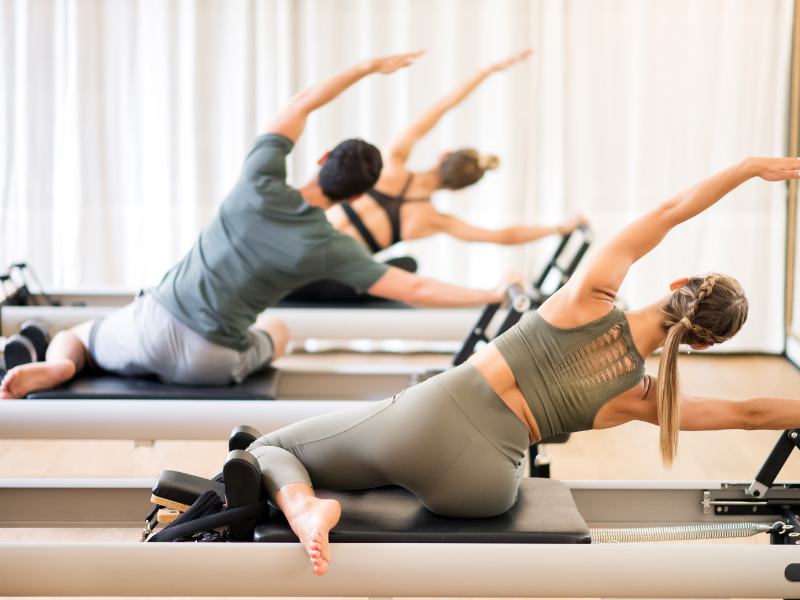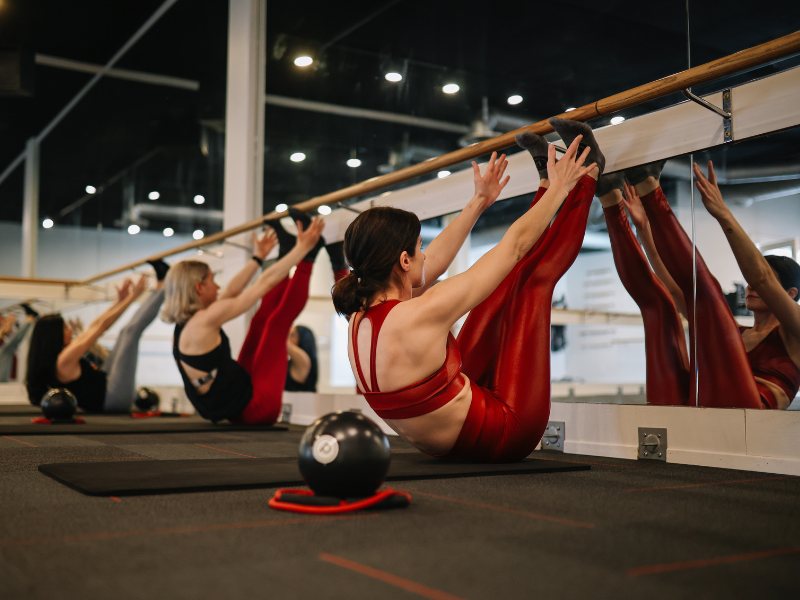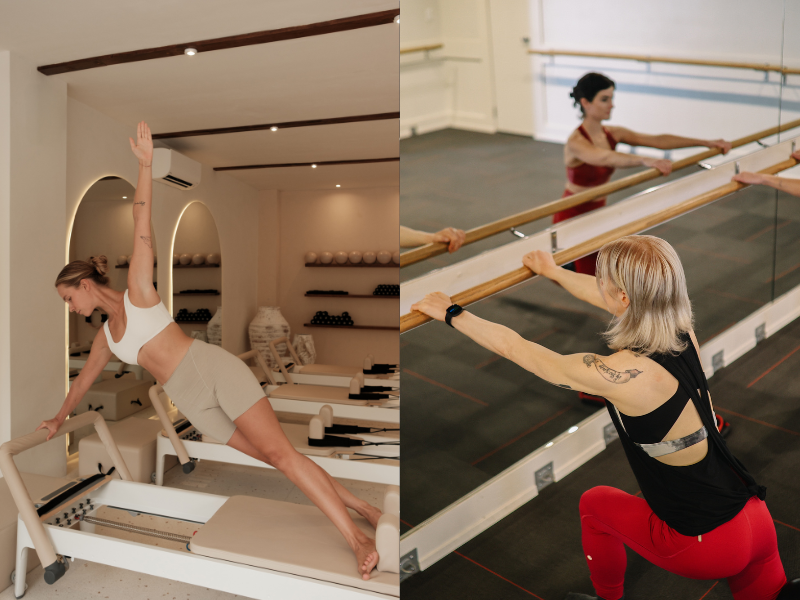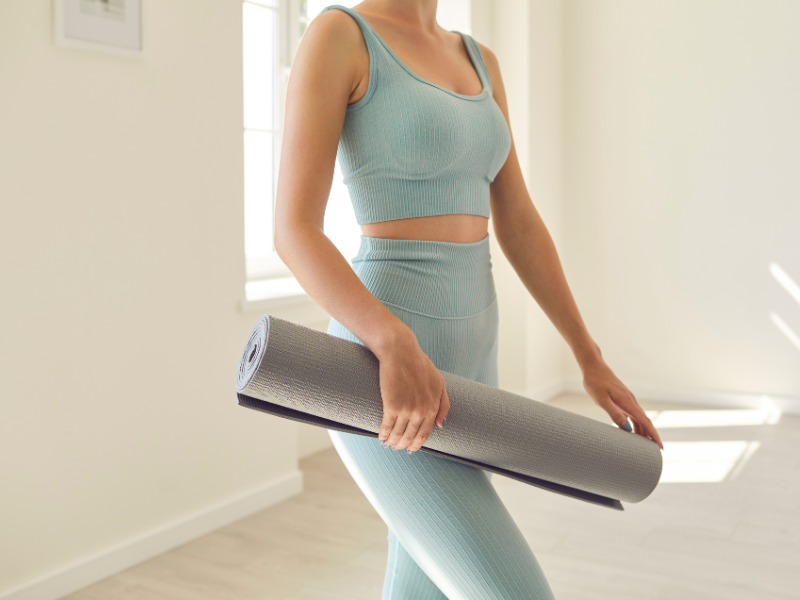


If you’re in search of a low-impact workout routine that can add definition to your physique while enhancing flexibility, barre and Pilates are sure to have come up. They might seem similar in many aspects, but they do have quite a few distinct traits that can help you with different fitness goals. To find out what might suit you better, read more to understand the intricacies of this workout style!
Barre Workout Style

Inspired by ballet and blending elements of Pilates, yoga styles, and strength training, barre has become quite a low-impact workout. It involves having a ballet barre for support and even light weights and resistance bands sometimes, but you don’t actually require any dance experience. A barre session revolves around training in high reps of small, controlled, and repetitive movements, targeting muscles that help with strength, balance, and stability.
It was developed by dancer Lotte Berk in the 1950s as a fusion of ballet exercises and rehabilitative therapy, and you can now find its evolution through popular methods like Pure Barre and The Bar Method. The idea behind these classes is to combine muscle-burning routines with deep stretching, pushing these muscles to fatigue and then lengthening them to boost flexibility and endurance, all while being joint-friendly.
Benefits of Barre
Barre is especially effective at targeting stabilizing muscles in the core, glutes, and legs, which can improve posture and overall strength without putting stress on the joints [1]. Many classes also include deep stretches to support mobility and reduce the risk of injury—something that’s key for both athletic performance and everyday movement.
Aside from the physical benefits, barre promotes a strong mind-body connection by encouraging focus and precision, which can help relieve stress and improve body awareness over time [2]. Altogether, it’s a well-rounded, accessible workout that supports strength, endurance, and mental clarity.
Pilates Workout Style

Pilates is a low-impact workout created in the 1920s by Joseph Pilates. Its main intention is to be a rehabilitation method that focuses on breath work and form to build stability and enhance joint health. Pilates exercises involve controlled and precise movements to enhance core strength, improve flexibility, and improve overall body alignment. You can find different types, like reformer Pilates and mat Pilates classes, where you either train with specialized equipment like the reformer or just require a mat.
Benefits of Pilates
Pilates is a low-impact workout that helps you build real, functional strength—especially in your core. By targeting deep muscles like the pelvic floor and lower abs, it can improve posture, balance, and body alignment, which makes everyday movement feel more stable and supported [3]. Because the movements are slow and controlled, it’s also a great option if you’re recovering from an injury or looking for a way to stay strong without stressing your joints.
Beyond the physical benefits, Pilates puts a big focus on breathwork and body awareness, which can help clear your head and ease stress. Whether you’re using a mat or a reformer, it’s a thoughtful, full-body workout that builds strength and leaves you feeling more grounded.
Learn more about Pilates:
Wall Pilates For Weight Loss: A Guide To The Best Exercises
Pilates Reformer Workout Plan PDF
Similarities Between Barre and Pilates
Below are significant parallels you can draw from both these low-impact training styles!

Low-Impact Strength Training: The most evident similarity is that both of these workout styles use controlled, joint-friendly movements that are ideal for developing better strength.
Core-Centric Focus: Focusing on core muscles plays a major role in these exercises, helping with posture, stability, and injury prevention.
Improves Flexibility & Mobility: Stretching and lengthening of movements for muscles are part of both training styles, which help with better range of motion and muscle elasticity.
Minimal Equipment Needed: They are great choices for home workouts as both Pilates and barre can be done at home with just a mat or small weights and bands.
Mind-Body Connection: Pilates and barre exercises help with achieving mental clarity and reducing stress through breathwork and conscious movements.
Barre vs Pilates: Key Differences
Below are the main differences you can observe between pilates exercises and barre sessions
Tools and Equipment: For barre classes, you usually use simple tools like a ballet barre, light weights, and resistance bands. But for Pilates like the reformer Pilates kind, you require a specialized reformer machine that helps you add resistance and variety to your workout.
Style of Movement: Barre revolves In barre, you target specific muscles through tiny, pulsing movements and it’s often to some fun music. Pilates focuses on slow, full-range movements along with a strong emphasis on improved posture.
Cardio vs. Control: Barre can be associated with more cardio elements, as it has a faster pace with more dynamic sequences. Pilates generally more focuses on slow, intentional movements and breath control, with less of a cardio push.
You may also like:
Pilates Workout: What Is It, its Benefits and Tips on Getting Started
Mat Pilates Workout For A Stronger and Leaner Look
How to Choose the Better Workout for You

This entirely depends on your fitness goals and what you prefer, whether you’re looking to manage your. body weight, redefine your physique, or have many other fitness goals in mind. If you enjoy training to some fun jams with precise movements that can help with sculpting your lower body, barre workouts can be a great fit. On the other hand, if you’re into more controlled full-body movements that can help you develop killer core strength and posture, then Pilates is the way to go. It’s also great for rehabilitation from injuries, muscular endurance, and if you are drawn to mindful movement practices.
Both these styles can be a great addition to your fitness routine, being low-impact exercises that are beginner-friendly. If you’re unsure of what to choose still, try out both and see what works for your entire body, or you can add elements of both to your routine too!
Conclusion
We hope that this article has helped you understand the details that go into each of these workout styles. Both barre and Pilates have their own distinctive identity bound by the commonality of low-impact exercises, so with this information in mind, you can choose what aligns with different fitness levels and goals! For an extensive library of Pilates videos and more, check out the JustFit app!





